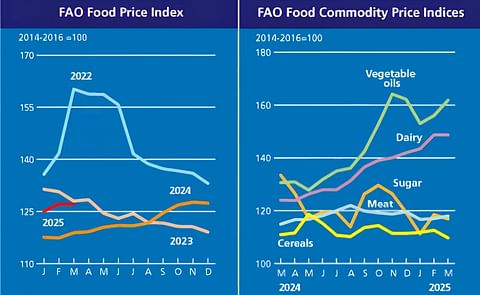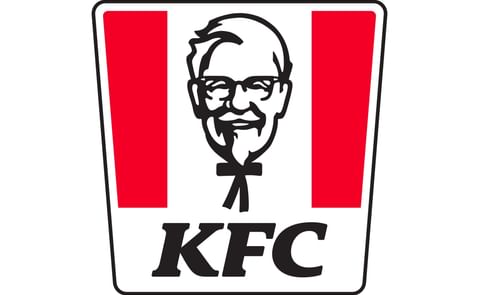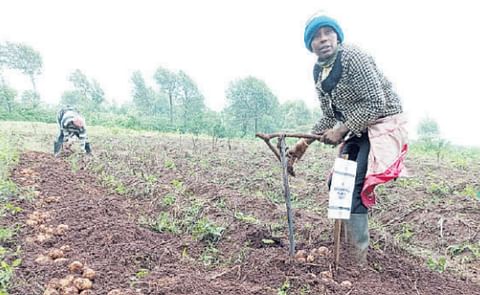FAO Food Price Index drops in August, reversing the slight rebound of the previous month
FAO Food Price Index drops in August, reversing the slight rebound of the previous month
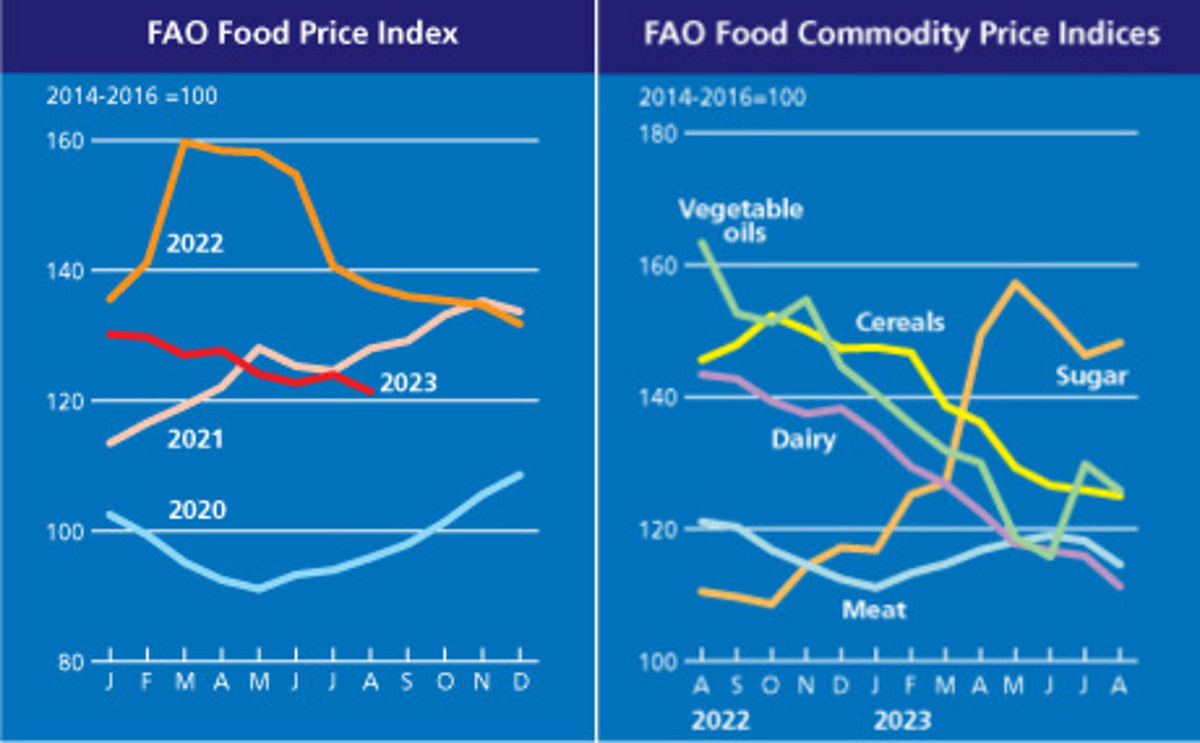
The FAO Food Price Index* (FFPI) averaged 121.4 points in August 2023, down 2.6 points (2.1 percent) from July, reversing the rebound registered last month and pushing the index as much as 38.3 points (24.0 percent) below its peak reached in March 2022. The drop reflected declines in the price indices for dairy products, vegetable oils, meat and cereals, while the sugar price index increased moderately.
The FAO Cereal Price Index averaged 125.0 points in August, down 0.9 points (0.7 percent) from July and standing 20.6 points (14.1 percent) below its value a year ago. International wheat prices fell by 3.8 percent, mostly reflecting higher seasonal availability from ongoing harvests in several leading exporters in the northern hemisphere.
International coarse grain prices also declined in August by 3.4 percent. Maize prices fell for the seventh consecutive month, hitting their lowest value since September 2020, underpinned by ample global supplies from a record harvest in Brazil and the start of the harvest in the United States of America.
Among other coarse grains, world prices of sorghum declined in August, pressured by the start of the harvest in the United States of America, the world’s largest sorghum exporter, while world barley prices firmed slightly. By contrast, the FAO All Rice Price Index in August rose by 9.8 percent month-on-month to reach a 15-year nominal high, reflecting trade disruptions registered in the aftermath of India's July ban on Indica white rice exports.
Against a backdrop of seasonally tight availabilities ahead of new-crop harvests, uncertainty over the ban’s duration and concerns that export restrictions would be extended to other rice types caused supply-chain actors to hold on to stocks, re-negotiate contracts or stop making price offers, thereby limiting most trade to small volumes or to previously concluded sales.
The FAO Vegetable Oil Price Index averaged 125.8 points in August, down 4.0 points (3.1 percent) month-on-month after a short-lived increase in July. The decline reflected lower world prices across palm, sunflower, soy and rapeseed oils.
International palm oil prices fell moderately in August, mainly underpinned by subdued global import purchases as well as seasonally rising outputs in leading producing countries in Southeast Asia.
In the meantime, world prices of sunflower oil declined by nearly 8 percent from the previous month amid weakening import demand that coincided with abundant offers from major exporters. As for soy and rapeseed oils, world prices dropped due to improving soybean crop conditions in the United States of America and ample global exportable supplies, respectively.
The FAO Dairy Price Index averaged 111.3 points in August, down 4.6 points (4.0 percent) from July, marking the eighth consecutive monthly decline, and as much as 32.1 points (22.4 percent) below its corresponding value last year.
In August, international prices across all dairy products declined, with whole milk powder prices falling the most, influenced by abundant supplies especially from Oceania amid seasonally rising production, together with a slowdown in the pace of imports by China, although import volumes remained relatively high.
Skim milk powder prices fell to their lowest level since mid-2020 due to subdued import demand and the lacklustre market activities associated with the summer holidays in Europe. Moreover, international butter and cheese prices dropped, reflecting similar factors coupled with steady production schedules in Oceania.
The FAO Meat Price Index* averaged 114.6 points in August, down 3.6 points (3.0 percent) from July and 6.5 points (5.4 percent) from its value a year ago. International prices of all meat types fell in August, with the steepest drop registered for ovine meat, principally underpinned by a surge in export availabilities, mainly from Australia, and weaker demand from China.
Pig meat prices declined, driven primarily by subdued import demand from leading importers, in tandem with abundant export availabilities in Europe amid limited internal sales.
World poultry meat prices continued to decrease in August, principally underpinned by abundant supplies, especially from Brazil, despite large purchases by several leading importers in East Asia and the Middle East. Bovine meat prices fell moderately due to ample supplies of slaughter-ready cattle in several leading producing countries and subdued import demand, especially in North Asia.
The FAO Sugar Price Index averaged 148.2 points in August, up 1.9 points (1.3 percent) from July and as much as 37.7 points (34.1 percent) from its level in the same month last year. The increase in world sugar prices was mainly triggered by heightened concerns over the impact of the El Niño weather phenomenon on global production prospects.
In India, below-average rains in August were detrimental to sugarcane crop development, while persistent dry weather conditions in Thailand are expected to negatively affect the 2023/24 sugar production.
In Brazil, rains hampered field operations in some areas; however, the large crop currently being harvested limited the upward pressure on world sugar prices. The weakening of the Brazilian Real against the United States dollar and lower ethanol prices also contributed to curbing the rise in world sugar prices.
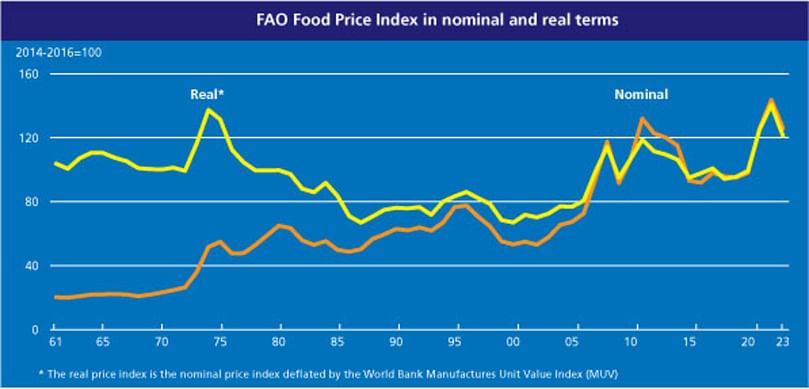 fao-english-1200.jpg
fao-english-1200.jpg
The FAO Cereal Price Index averaged 125.0 points in August, down 0.9 points (0.7 percent) from July and standing 20.6 points (14.1 percent) below its value a year ago. International wheat prices fell by 3.8 percent, mostly reflecting higher seasonal availability from ongoing harvests in several leading exporters in the northern hemisphere.
International coarse grain prices also declined in August by 3.4 percent. Maize prices fell for the seventh consecutive month, hitting their lowest value since September 2020, underpinned by ample global supplies from a record harvest in Brazil and the start of the harvest in the United States of America.
Among other coarse grains, world prices of sorghum declined in August, pressured by the start of the harvest in the United States of America, the world’s largest sorghum exporter, while world barley prices firmed slightly. By contrast, the FAO All Rice Price Index in August rose by 9.8 percent month-on-month to reach a 15-year nominal high, reflecting trade disruptions registered in the aftermath of India's July ban on Indica white rice exports.
Against a backdrop of seasonally tight availabilities ahead of new-crop harvests, uncertainty over the ban’s duration and concerns that export restrictions would be extended to other rice types caused supply-chain actors to hold on to stocks, re-negotiate contracts or stop making price offers, thereby limiting most trade to small volumes or to previously concluded sales.
The FAO Vegetable Oil Price Index averaged 125.8 points in August, down 4.0 points (3.1 percent) month-on-month after a short-lived increase in July. The decline reflected lower world prices across palm, sunflower, soy and rapeseed oils.
International palm oil prices fell moderately in August, mainly underpinned by subdued global import purchases as well as seasonally rising outputs in leading producing countries in Southeast Asia.
In the meantime, world prices of sunflower oil declined by nearly 8 percent from the previous month amid weakening import demand that coincided with abundant offers from major exporters. As for soy and rapeseed oils, world prices dropped due to improving soybean crop conditions in the United States of America and ample global exportable supplies, respectively.
The FAO Dairy Price Index averaged 111.3 points in August, down 4.6 points (4.0 percent) from July, marking the eighth consecutive monthly decline, and as much as 32.1 points (22.4 percent) below its corresponding value last year.
In August, international prices across all dairy products declined, with whole milk powder prices falling the most, influenced by abundant supplies especially from Oceania amid seasonally rising production, together with a slowdown in the pace of imports by China, although import volumes remained relatively high.
Skim milk powder prices fell to their lowest level since mid-2020 due to subdued import demand and the lacklustre market activities associated with the summer holidays in Europe. Moreover, international butter and cheese prices dropped, reflecting similar factors coupled with steady production schedules in Oceania.
The FAO Meat Price Index* averaged 114.6 points in August, down 3.6 points (3.0 percent) from July and 6.5 points (5.4 percent) from its value a year ago. International prices of all meat types fell in August, with the steepest drop registered for ovine meat, principally underpinned by a surge in export availabilities, mainly from Australia, and weaker demand from China.
Pig meat prices declined, driven primarily by subdued import demand from leading importers, in tandem with abundant export availabilities in Europe amid limited internal sales.
World poultry meat prices continued to decrease in August, principally underpinned by abundant supplies, especially from Brazil, despite large purchases by several leading importers in East Asia and the Middle East. Bovine meat prices fell moderately due to ample supplies of slaughter-ready cattle in several leading producing countries and subdued import demand, especially in North Asia.
The FAO Sugar Price Index averaged 148.2 points in August, up 1.9 points (1.3 percent) from July and as much as 37.7 points (34.1 percent) from its level in the same month last year. The increase in world sugar prices was mainly triggered by heightened concerns over the impact of the El Niño weather phenomenon on global production prospects.
In India, below-average rains in August were detrimental to sugarcane crop development, while persistent dry weather conditions in Thailand are expected to negatively affect the 2023/24 sugar production.
In Brazil, rains hampered field operations in some areas; however, the large crop currently being harvested limited the upward pressure on world sugar prices. The weakening of the Brazilian Real against the United States dollar and lower ethanol prices also contributed to curbing the rise in world sugar prices.
*Unlike for other commodity groups, most prices utilized in the calculation of the FAO Meat Price Index are not available when the FAO Food Price Index is computed and published; therefore, the value of the Meat Price Index for the most recent months is derived from a mixture of projected and observed prices. This can, at times, require significant revisions in the final value of the FAO Meat Price Index which could in turn influence the value of the FAO Food Price Index.

FAO Food Price Index in nominal and real terms
Like to receive news like this by email? Join and Subscribe!
NEW! Join Our BlueSky Channel for regular updates!
Highlighted Company
Sponsored Content
Sponsored Content
Sponsored Content
Sponsored Content
Sponsored Content



